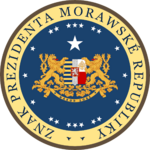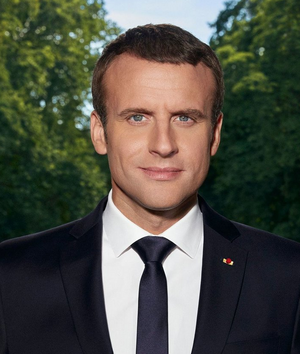President of Morrawia
| President of the Republic of Morrawia | |
|---|---|
| Prezident Morawské republiky | |
 | |
 | |
| Style |
|
| Type | |
| Abbreviation | POTROM (Common) PMR (Morrawian) |
| Member of | |
| Residence | National House |
| Seat | Králowec, F.D. |
| Appointer | Popular vote or via succession |
| Term length | Four years, renewable once |
| Constituting instrument | Constitution of Morrawia |
| Formation | April 20, 1856 |
| First holder | Tristan Palacký |
| Salary | ₮815,000 per year |
| Website | www |
The president of Morrawia, officially the president of the Republic of Morrawia, is the head of state and head of government of the Republic of Morrawia. The president directs the executive branch of the federal government and is the commander-in-chief of the Morrawian Armed Forces.
The power of the presidency has grown substantially since the first president, Tristan Palacký, took office in 1856. While presidential power has ebbed and flowed over time, the presidency has played an increasingly significant role in Morrawian political life since the beginning of the 20th century, carrying over into the 21st century with notable expansions during the presidencies of Karel Tusar and Josef Sokol. In modern times, the president is one of the world's most powerful political figures. As the leader of the nation with the an increasing economy by nominal GDP, the president possesses significant domestic and international hard and soft power. For much of the 20th century, especially during the Era of Civil Wars, the Morrawian president was often called "free world president", given Morrawia´s usual international stance as a supporter of free, independent, democratic and capitalist nations.
Article II of the Constitution establishes the executive branch of the federal government and vests executive power in the president. The power includes the execution and enforcement of federal law and the responsibility to appoint federal executive, diplomatic, regulatory, and judicial officers. Based on constitutional provisions empowering the president to appoint and receive ambassadors and conclude treaties with foreign powers, and on subsequent laws enacted by the Federal Congress, the modern presidency has primary responsibility for conducting Morrawian foreign policy. The role includes responsibility for directing the the Morrawian military, which has a substantial nuclear arsenal.
The president also plays a leading role in federal legislation and domestic policymaking. As part of the system of separation of powers, Article II, Section 5 of the Constitution gives the president the power to sign or veto federal legislation. Since modern presidents are typically viewed as leaders of their political parties, major policymaking is significantly shaped by the outcome of presidential elections, with presidents taking an active role in promoting their policy priorities to members of the Federal Congress who are often electorally dependent on the president. In recent decades, presidents have also made increasing use of presidential directives, agency regulations, and judicial appointments to shape domestic policy.
The president is elected directly through the popular vote to a four-year term, along with the vice president. Under the Thirty-first Amendment, ratified in 1942, no person who has been elected to two presidential terms may be elected to a third. In addition, four vice presidents have become president by virtue of a president's intra-term death, formal removal or resignation. In all, 32 individuals have served 32 presidencies spanning 168 years of history. Marcel Pelikán is the 32nd and current president of Morrawia, having assumed office on April 15, 2024.
History and development
Origins
1876-1900
New Wave
Radical Presidency
Contemporary Period
Legislative powers
Signing and vetoing bills
Setting the agenda
Promulgating regulations
Convening and adjourning the Federal Congress
Executive powers
Administrative powers
Foreign affairs
Commander-in-chief
Juridical powers and privileges
Leadership roles
Selection process
Incumbency
Post-presidency
Political affiliation
Timeline of presidents
The following timeline depicts the progression of the presidents and their political affiliation at the time of assuming office:
